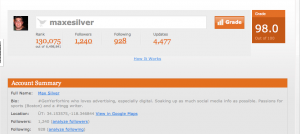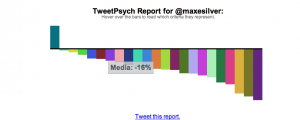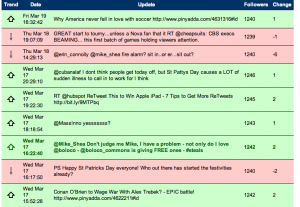 As a heavy Twitter user, I am always looking for ways to improve my tweeting to make it more interesting to others. Over the last year or so I have found some great and unique Twitter analytics sites that have allowed me to learn about my Twitter habits and improve my content distribution.
As a heavy Twitter user, I am always looking for ways to improve my tweeting to make it more interesting to others. Over the last year or so I have found some great and unique Twitter analytics sites that have allowed me to learn about my Twitter habits and improve my content distribution.
Below you’ll find what I think are the five best analytics sites to help you determine what kind of Twitter user you are, how much influence you have, and many other facts about your usage. I will kick the list off with a tool that was created by a Boston-based company you just might have heard about before:

Twitter Grader
Twitter Grader is brought to us by our Cambridge based friends over at HubSpot, and is known as one of the original and most reliable Twitter analytics tools available. This was the first Twitter analytics tool I ever used, and through its tips and tweet cloud I was able to better understand what I needed to do to improve my tweeting.
Hubspot provides an explanation on how they come up with your score. Looking at this will help you understand how to strengthen your Twitter “brand.” The key areas they take into account are the number and power of your followers, how often and with what frequency you post, and your engagement. If you can work on those areas, you will soon find yourself with a high score on Twitter Grader.
One other great way to use Grader is to poke around and find influencers, or “Twitter Elite” in your area. The highest scored users for different cities are listed, and if you are new to Twitter it is a good way to find interesting people to follow

Klout
This analytics site gives a wide variety of Twitter statistics for you to digest. The Klout score is split up into four categories: Reach, Demand, Engagement, and Velocity. Within each of these are a subset of percentages and ratios that allow you to see some very valuable insights into how you tweet, and how your followers respond to your tweeting.
My favorite part of Klout is another analysis they run. They create an X Y axis that has four areas; Connector, Persona, Climber and Casual. Through the statistics listed above they will plot you on this chart. They also plot people they believe to be key influencers of you, as well as people that you influence. This gives a more broad look at your Twitter style, which can is often easier to digest than other statistics.

Like Klout, Twinfluence is based on four core statistics: Second-order Followers, Velocity, Social Capital, and Centralization. Seeing second-order followers can be a bit surreal, because they represent the followers of your followers — and that is often a surprisingly high number of people.
The real value coming from Twinfluence though, is in the social capital and centralization categories.
The social capital represents how influential your followers are, which in turn reflects on how well you are able to distribute content and gain new, valuable followers. This isn’t a completely new statistic, but I find it well done here.
On the other hand, centralization is a completely new concept to me that I find very interesting. This measures how dependent you are on certain pockets of followers. So, if you are only influenced by and influence a very small group, then you will have a high score. But, if you are independent of all followers, you will have a lower score.

This analytics site was created by Dan Zarrella (@danzarrella) of HubSpot, who is known for his excellent work creating measurable analytics in the social space, particularly with Twitter.
Tweetpsych takes a very different approach to the analyzation of tweet streams than the rest on this list, but it tells you the most about what you actually tweet about. Within the site are the average number of tweets about a lot of common subjects (i.e. money, self, control, media, past, leisure, etc). After crawling your tweet stream, it then shows you how much more or less often you tweet about all of these subjects than the average user.
This is useful to you because it allows you to see if you are talking about certain categories too often, such as yourself, that might turn off people from following you. Or maybe the fact that you are a very negative tweeter might not entice people to follow you.
Dan Zarrella has hit home with another unique and insightful Twitter analytics site with Tweetpsych and HubSpot is lucky to have him.

While all the other sites I have listed give you great insights into your tweeting habits, Tweeteffect shows direct correlation between what you tweet and the followers you gain and lose. Seeing this direct correlation does more then give you insights, it flat out lays down what is working and not working for you.
Every time you gain or lose followers, Tweeteffect shows you what tweet the change came after, and how many followers you actually gained or lost. You can easily scroll down through many of your tweets to see what kind of content has or hasn’t been working for you.
Unfortunately, there is one small problem with this analytics site: Followers come and go for many reasons, not just because of certain tweets. Twitter bots often are in and out of your follower count, and you certainly don’t lose one of them because of a tweet. So, you do have to do a little reading between the lines to find what content is doing to your followers, but overall it is a very effective tool.
Want just one more?
GraphEdge
This Boston-based Twitter analytics tool was developed by Bostinno friend Waldron Faulkner. It will cost most of you about $5 per month to use, but GraphEdge offers some pretty sweet stuff, like who your most influential followers are and who else your followers are following.
What are your favorite Twitter analytics tools? Are these things just a load of bull? How do you define a Twitter power-user? Let us know in the comments section.
Editor’s Note: Max Silver is a senior marketing communications major at Emerson College. He’s a Twitter junkie and loves all things realtime. For more of his work, check out TheNextGreatGeneration.com, as well as his personal blog. Follow him on Twitter @maxesilver and find him on Linkedin. He loves connecting with people and talking tech and social media.
